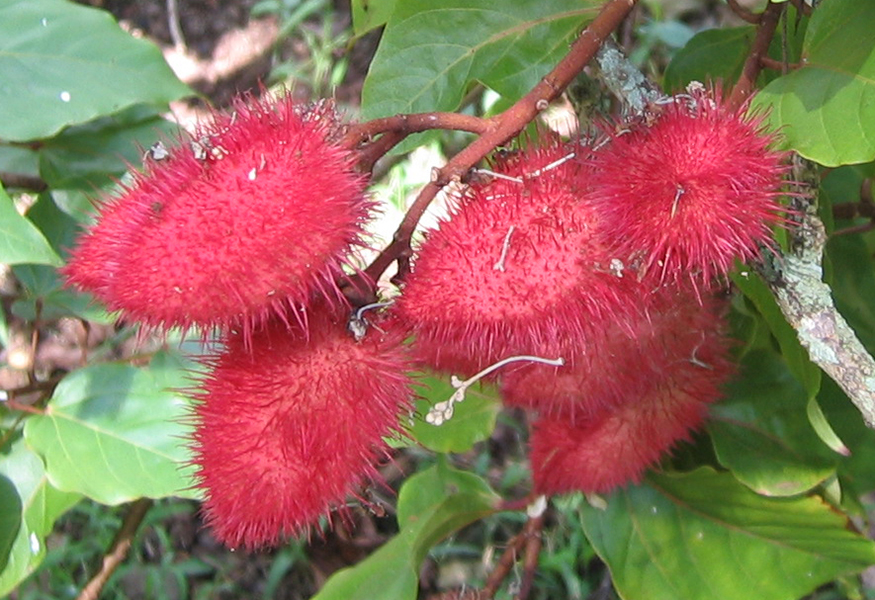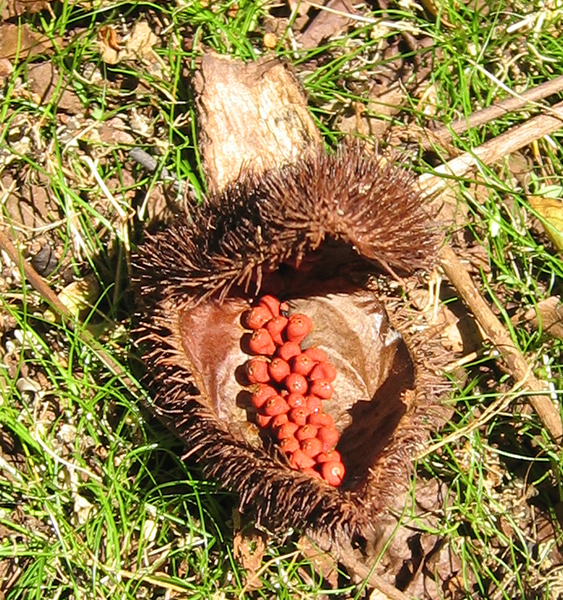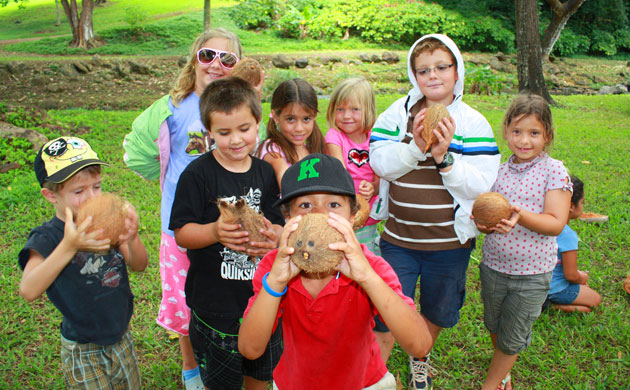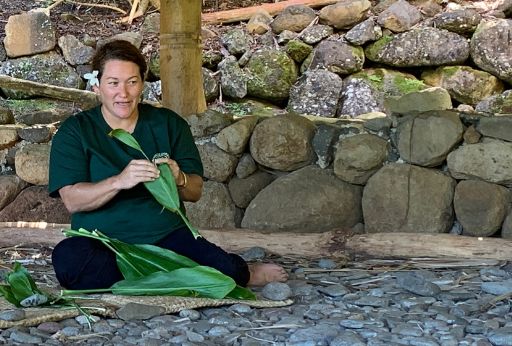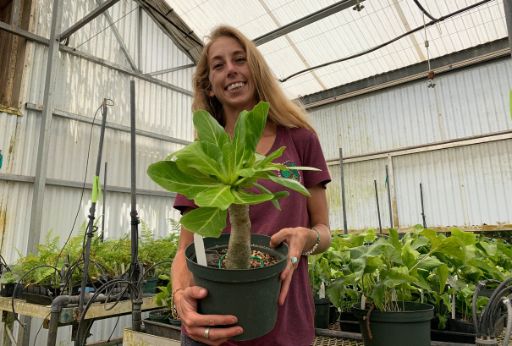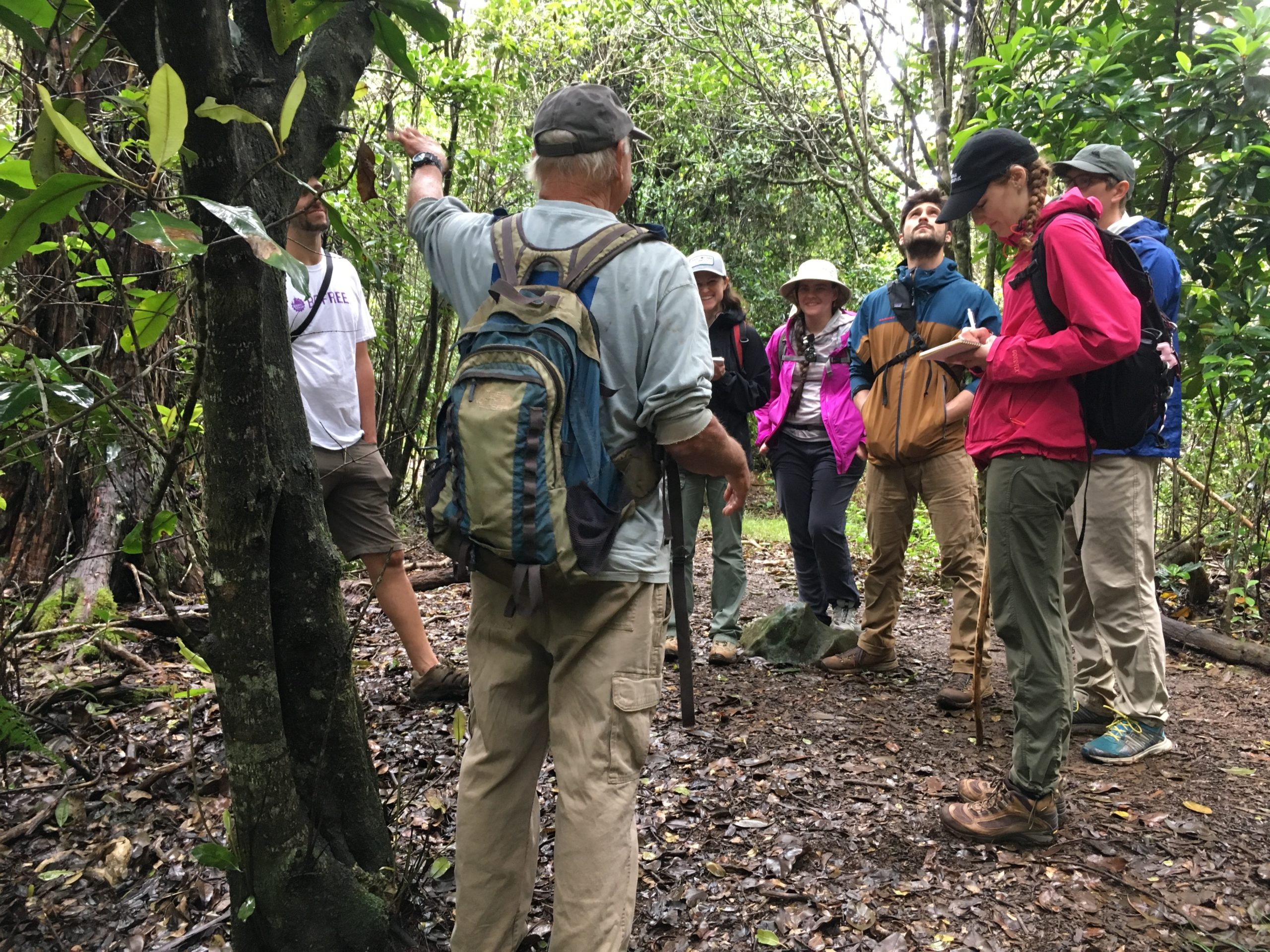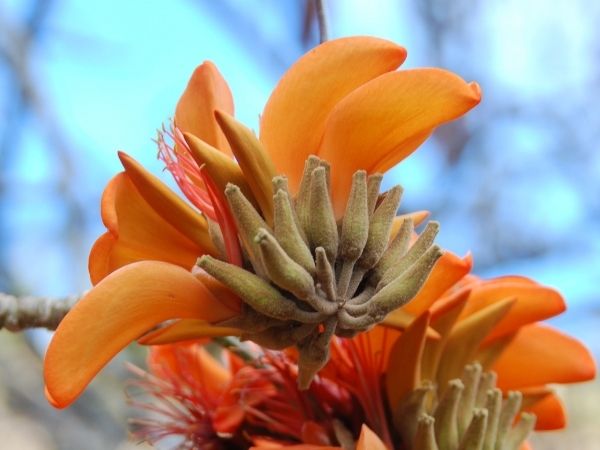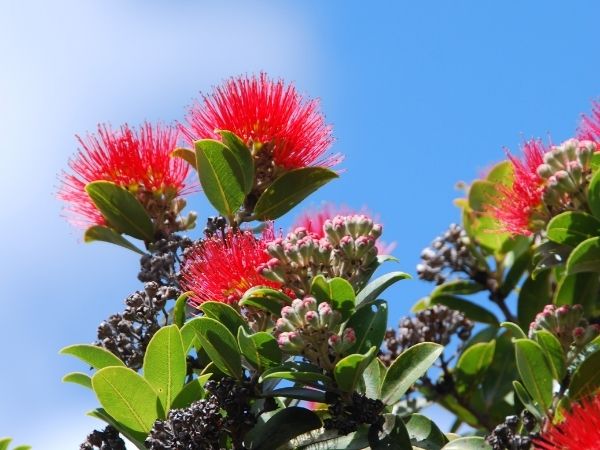Tropical Plant Database - Plant Details
Bixa orellana
Click on any heading above to view more information about this plant
Conservation Status
- IUCN: least concern
- USFWS: None
David Lorence, PhD, NTBG Director of Science, talking about Bixa orellana
Family: BIXACEAE
Genus: Bixa
Species: orellana
Species Author: L.
Vernacular: Doaloa rice - Pohnpeian [Dores 207]
Genus: Bixa
Species: orellana
Species Author: L.
Vernacular: Doaloa rice - Pohnpeian [Dores 207]
A profusely fruiting shrub, reaching 6 - 20 feet tall and age up to about 50 years. Annato has pointed leaves and pink, white or a pinkish-white flowers. The seeds are small reddish-orange inside a prickly heartshaped pod. Approximately 50 seeds grow inside of the pod. Depending on the color of the flowers, the seedpod is either green or red. The seeds have the same coating in both color.
(Stone. 1970.)
(Stone. 1970.)
In Suriname's traditional medicine, the entire plant is used against fever and dysentery. A decoction of the leaves is used to stop vomiting and nausea. The seeds are used against: sinusitis, asthma, constipation and skin disorders and uteritis.
Although mostly only the seed paste or seed oil(annatto oil is emollient and the content has antioxidant properties) is used commercially today, the rainforest tribes have used the entire plant as medicine for centuries. A tea made with the young shoots is used by the Piura tribe as an antidysenteric, aphrodisiac, and astringent and to treat skin problems, fevers, and hepatitis. The leaves are used to treat skin problems, liver disease, and hepatitis. It has also been considered good for the digestive system. An infusion of the flowers is used by the Cojedes tribes as a purgative and to avoid phlegm in newborn babies.
Traditional healers in Colombia have also used annatto as an antivenin for snakebites. The seeds are believed to be an expectorant while the roots are thought to be a digestive and antitussive (for coughs).
Today in Brazilian herbal medicine, a leaf decoction of annatto is used to treat heartburn and stomach distress caused by spicy foods, and as a mild diuretic and mild purgative. It is also used for fevers and malaria, and, topically, to treat burns.
Annatto is a common remedy in Peruvian herbal medicine today, and the dried leaves are called achiotec. Eight to 10 dried leaves are boiled for 10 minutes in 1 liter of water for this popular Peruvian remedy. One cup is drunk warm or cold 3 times daily after meals to treat prostate disorders and internal inflammation, arterial hypertension, high cholesterol, cystitis, obesity, renal insufficiency, and to eliminate uric acid. This decoction is also recommended as a vaginal antiseptic and cicatrizant, as a wash for skin infections, and for liver and stomach disorders.
Curanderos in the Peruvian Amazon squeeze the juice from the fresh leaves and place it in the eye for inflammation and eye infections, and they use the juice of 12 fruits taken twice daily for 5 days to cure epilepsy.
Although not widely available in the United States, standard decoctions of annatto leaves are taken by the half-cupful 2-3 times daily for prostate and urinary difficulties as well as high cholesterol and hypertension. Ground annatto seed powder is also used in small dosages of 1-20 mg daily for high cholesterol and hypertension. Higher dosages can cause a marked increase in urination.
It has been noted that some individuals are highly sensitive to annatto seed and this diuretic effect can be caused at much lower doses, even by just eating a bag of popcorn in which annatto was used as a coloring or flavoring ingredient.
(Taylor, L. 2002. Herbal Secrets of the Rainforest.)
Although mostly only the seed paste or seed oil(annatto oil is emollient and the content has antioxidant properties) is used commercially today, the rainforest tribes have used the entire plant as medicine for centuries. A tea made with the young shoots is used by the Piura tribe as an antidysenteric, aphrodisiac, and astringent and to treat skin problems, fevers, and hepatitis. The leaves are used to treat skin problems, liver disease, and hepatitis. It has also been considered good for the digestive system. An infusion of the flowers is used by the Cojedes tribes as a purgative and to avoid phlegm in newborn babies.
Traditional healers in Colombia have also used annatto as an antivenin for snakebites. The seeds are believed to be an expectorant while the roots are thought to be a digestive and antitussive (for coughs).
Today in Brazilian herbal medicine, a leaf decoction of annatto is used to treat heartburn and stomach distress caused by spicy foods, and as a mild diuretic and mild purgative. It is also used for fevers and malaria, and, topically, to treat burns.
Annatto is a common remedy in Peruvian herbal medicine today, and the dried leaves are called achiotec. Eight to 10 dried leaves are boiled for 10 minutes in 1 liter of water for this popular Peruvian remedy. One cup is drunk warm or cold 3 times daily after meals to treat prostate disorders and internal inflammation, arterial hypertension, high cholesterol, cystitis, obesity, renal insufficiency, and to eliminate uric acid. This decoction is also recommended as a vaginal antiseptic and cicatrizant, as a wash for skin infections, and for liver and stomach disorders.
Curanderos in the Peruvian Amazon squeeze the juice from the fresh leaves and place it in the eye for inflammation and eye infections, and they use the juice of 12 fruits taken twice daily for 5 days to cure epilepsy.
Although not widely available in the United States, standard decoctions of annatto leaves are taken by the half-cupful 2-3 times daily for prostate and urinary difficulties as well as high cholesterol and hypertension. Ground annatto seed powder is also used in small dosages of 1-20 mg daily for high cholesterol and hypertension. Higher dosages can cause a marked increase in urination.
It has been noted that some individuals are highly sensitive to annatto seed and this diuretic effect can be caused at much lower doses, even by just eating a bag of popcorn in which annatto was used as a coloring or flavoring ingredient.
(Taylor, L. 2002. Herbal Secrets of the Rainforest.)
The indigenous people in Suriname have used the anatto seeds for many centuries as body paint during festivities, as a fabric dye, as a sunscreen and against insect bites.
It has been traced back to the ancient Mayan Indians, who employed it as a principal coloring agent in foods, for body paints, and as a coloring for arts, crafts, and murals.
Annatto paste is also used as a natural dye for cloth and wool and is sometimes employed in the paint, varnish, lacquer, cosmetic, and soap industries.
(Taylor, L. 2002. Herbal Secrets of the Rainforest.)
(Information for this species compiled and recorded by Camelia Cirnaru, NTBG Consultant.)
It has been traced back to the ancient Mayan Indians, who employed it as a principal coloring agent in foods, for body paints, and as a coloring for arts, crafts, and murals.
Annatto paste is also used as a natural dye for cloth and wool and is sometimes employed in the paint, varnish, lacquer, cosmetic, and soap industries.
(Taylor, L. 2002. Herbal Secrets of the Rainforest.)
(Information for this species compiled and recorded by Camelia Cirnaru, NTBG Consultant.)
A native of Tropical America and introduced to Guam by the Spanish from Mexico. In Hawai'i annatto is usually cultivated but also occasionally naturalized on edges of forest, in thickets, and in waste places
(Smith. 1981.)
(Smith. 1981.)
The seeds are processed to obtain the orange-yellow pigments, bixin and norbixin (carotenoids). Traditionally, the crushed seeds are soaked in water that is allowed to evaporate. The resulted dye is used to color the cheddar cheese and is also used for the coloring of rice, soups, microwave popcorn and other foods to give them a bright yellow or orange color. Many times, this food coloring replaces the very expensive saffron in recipes and dishes around the world.
(Taylor, L. 2002. Herbal Secrets of the Rainforest.)
(Taylor, L. 2002. Herbal Secrets of the Rainforest.)
Much has been done in the laboratory validating annatto's traditional uses and offering new ones. A water extract of the root demonstrated hypotensive activity in rats, as Peruvian herbal systems have practiced. The same extract demonstrated smooth muscle-relaxant activity in guinea pigs and lowered gastric secretions in rats, which helps to explain its use as a digestive aid and for stomach disorders. Annatto seed extracts have been documented to raise blood glucose levels in some species of animals and to lower it in others. Annatto leaves were reported in yet another study to possess aldose reductase inhibition actions - a process implicated in the advancement of diabetic neuropathy. A 2000 study confirmed the effectiveness of a leaf-and-bark extract at neutralizing hemorrhages in mice injected with snake venom as has been practiced in Colombia for many years. Annatto demonstrated antigonorrheal activity in a 1995 study, and in other research, flower and leaf extracts demonstrated in vitro antibacterial activity against several bacteria including E. coli and Staphylococcus. This can certainly supports its use in traditional medicine systems for gonorrhea and other types of infections.
Analysis of annatto seeds suggest that they contain 40% to 45% cellulose, 3.5% to 5.5% sucrose, 0.3% to 0.9% essential oil, 3% fixed oil, 4.5% to 5.5% pigments, and 13% to 16% protein, as well as alpha- and beta-carotenoids and other constituents. Annatto oil is extracted from the seeds and is the main source of the pigments bixin and norbixin, which are classified as carotenoids. Bixin is used as a colorant in foods, is believed to have UV protection capabilities, and has shown antioxidant and liver protective properties.
Although its history of use as a food coloring is well established worldwide, current trends show that it is used increasingly in body care products. Annatto oil is an emollient, and its high carotenoid content provides beneficial antioxidant properties. In body care products, annatto oil provides antioxidant benefits while adding a rich, sunny color to creams, lotions, and shampoos.
(Dunham, N. W. et al. A preliminary pharmacologic investigation of the roots of Bixa orellana. J. Amer. Pharm. Ass. Sci. Ed. 1960.)
(Morrison, E. Y., et al. Extraction of an hyperglycaemic principle from the annatto (Bixa orellana), a medicinal plant in the West Indies. Trop. Georg. Med. 1991.)
(Morrison, E. Y., et al. Toxicity of the hyperglycaemic-inducing extract of the annatto (Bixa orellana) in the dog. West Indian Med. J. 1985.)
(Morrison, E. Y., et al. The effect of Bixa orellana (annatto) on blood sugar levels in the anaesthetized dog. West Indian Med. J.1985.)
(Terashima, S., et al. Studies on aldose reductase inhibitors from natural products. IV. Constituents and aldose reductase inhibitory effect of Chrysanthemum morifolium, Bixa orellana and Ipomoea batatas. Chem. Pharm. Bull. 1991.)
(Otero, R., et al. Snakebites and ethnobotany in the northwest region of Colombia. Part III: neutralization of lethal and enzymatic effects of Bothrops atrox venom. J. Ethnopharmacol. 2000.)
(Caceres A., et al. Antigonorrhoeal activity of plants used in Guatemala for the treatment of sexually transmitted diseases. J. Ethnopharmacol. 1995.)
(George, M., et al. Investigations on plant antibiotics. Part IV. Further search for antibiotic substances in Indian medicinal plants. Indian J. Med. Res. 1949.)
(Bressani, R., et al. Chemical composition, amino acid content and nutritive value of the protein of the annatto seed (Bixa orellana L.) Arch. Latinoam. Nutr.)
Analysis of annatto seeds suggest that they contain 40% to 45% cellulose, 3.5% to 5.5% sucrose, 0.3% to 0.9% essential oil, 3% fixed oil, 4.5% to 5.5% pigments, and 13% to 16% protein, as well as alpha- and beta-carotenoids and other constituents. Annatto oil is extracted from the seeds and is the main source of the pigments bixin and norbixin, which are classified as carotenoids. Bixin is used as a colorant in foods, is believed to have UV protection capabilities, and has shown antioxidant and liver protective properties.
Although its history of use as a food coloring is well established worldwide, current trends show that it is used increasingly in body care products. Annatto oil is an emollient, and its high carotenoid content provides beneficial antioxidant properties. In body care products, annatto oil provides antioxidant benefits while adding a rich, sunny color to creams, lotions, and shampoos.
(Dunham, N. W. et al. A preliminary pharmacologic investigation of the roots of Bixa orellana. J. Amer. Pharm. Ass. Sci. Ed. 1960.)
(Morrison, E. Y., et al. Extraction of an hyperglycaemic principle from the annatto (Bixa orellana), a medicinal plant in the West Indies. Trop. Georg. Med. 1991.)
(Morrison, E. Y., et al. Toxicity of the hyperglycaemic-inducing extract of the annatto (Bixa orellana) in the dog. West Indian Med. J. 1985.)
(Morrison, E. Y., et al. The effect of Bixa orellana (annatto) on blood sugar levels in the anaesthetized dog. West Indian Med. J.1985.)
(Terashima, S., et al. Studies on aldose reductase inhibitors from natural products. IV. Constituents and aldose reductase inhibitory effect of Chrysanthemum morifolium, Bixa orellana and Ipomoea batatas. Chem. Pharm. Bull. 1991.)
(Otero, R., et al. Snakebites and ethnobotany in the northwest region of Colombia. Part III: neutralization of lethal and enzymatic effects of Bothrops atrox venom. J. Ethnopharmacol. 2000.)
(Caceres A., et al. Antigonorrhoeal activity of plants used in Guatemala for the treatment of sexually transmitted diseases. J. Ethnopharmacol. 1995.)
(George, M., et al. Investigations on plant antibiotics. Part IV. Further search for antibiotic substances in Indian medicinal plants. Indian J. Med. Res. 1949.)
(Bressani, R., et al. Chemical composition, amino acid content and nutritive value of the protein of the annatto seed (Bixa orellana L.) Arch. Latinoam. Nutr.)
- 089581 - collected by I. F. Fasavalu in 1970
- 089580 - collected by Art Whistler in 1973
- 004088 - collected by W. M. Bush in 1974
- 004090 - collected by Shawn Lum in 1983
- 004087 - collected by Tim Flynn in 1986
- 004089 - collected by Lynwood Hume in 1987
- 033314 - collected by Michael J. Balick in 1998
- S047651 - collected by David H. Lorence in 1999
- 043552 - collected by A. Dores in 2003
- 095307 - collected by S. T. Wakuk in 2006
- 056473 - collected by Natalia Tangalin in 2007
- 066384 - collected by David E. Brussell in 2008
- 096168 - collected by J. A. Sanney in 2008
- 051676 - collected by David H. Lorence in 2009
- 094392 - collected by Michael J. Balick in 2017
We currently have 15 herbarium specimens for Bixa orellana in our collection. Click on any specimen below to view the herbarium sheet data.
.svg)

